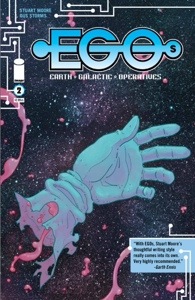Comic Review : EGOS #2
Much of this issue frames a vain battle that ends with a tragic defeat, not the kind that inspires an uplifting poem, like “The Charge of the Light Brigade,” but a run of the mill butt-kicking, like Custer’s Last Stand. Deuce, with clones and recruits in tow, confronts Quark and Masse, and the heroes become, in the main, fodder one and all for the cosmic cannibals. Back at Earthgov, we eavesdrop Pixel’s phone call to her mother in prison, and learn the super-villainess was disappointed by her daughter; she had expected a better template to use as a cornerstone for conquering the universe. Outside EGOs headquarters, there is a jammed-up queue of applicants waiting for their try-out for the EGOs team. We get to preview one of the applicants, a teenaged gate-teleporter with a steampunk costume, who uses her power to skip the line and meet another applicant named Pigmentia before she skips to the head of the line into Pixel’s office.
After a bloody massacre, some teenaged hijinx. This conflation of tragedy and comedy recalls Levitz and Giffen’s long and acclaimed run on Legion of Super-Heroes, and the genre mashing in EGOs is equally ambitious. Imagine, if you will, if Ziggy Stardust, via the power of glam holograms and wholesale cloning inspired by the pop nihilism of the Star Wars prequels, resurrected an entire generation of rock and roll superstars and KISS to lieutenant them. Then imagine The Legion of Substitute Heroes, except that their well-known bad luck has red shifted into the fatal luck of red shirts. EGOs exists somewhere in between. The miracle is that somehow this genre goulash and catwalk of bizarro fashions is pretty darn good.
Still, reading EGOs is an imperfect pleasure. There are some concerns. The most obvious would be that the basic structure is borrowing a lot from Saga by having the narrator be the protagonists’ child. Image Comics is probably not intending to have a cottage industry of offspring-narrated imaginative fiction, so one can probably chalk this up in the “great minds think alike” column. Except for the fact that Saga does it much better, so the accident of similar structure remains troubling. Secondly, while the strife is believable, the grief is not. These characters haven’t earned their teary-eyed exchanges yet, and the emotions come off as emoting. This is bad to do early in a story, because crocodile tears just make a reader wary, not sympathetic. And to have characters indulging such copious sentiment without inspiring any feelings in the reader seems a little gratuitous. Thirdly is a lesson best learned from reading Lee & Kirby’s Fantastic Four: if you dream up big ideas, let them be front and center always and give them as much time and thought as your characters. In this second issue, Stuart Moore is clearly pushing his ideas to the back burner to make room for a phone call to mom and a massacre.
Still, one must admit it is a rather well-drawn phone call to mom. Gus Storms, for a neophyte, brings an extremely sophisticated sensibility to the pages of EGOs. Several reviews have compared his work favorably and unfavorably to the work of Frank Quitely, but the dynamic, crinkly lines and hewn faces in EGOs bear more resemblance to science fiction comics of the bande dessinée franco-belge persuasion, e.g. Valerian et Laureline, Les Naufrages du Temps, the work of Moebius. Storms draws gorgeous panels, with a pastel dynamism that pushes the story along. His page layouts are a little conservative, but it is understandable that an artist doing line, ink, and colors all by himself would prefer a consistency in the size of each panel.
EGOs is published by Image Comics. If you can’t find it at your local comic shop, both issues are available on the Image website and on comiXology. It is recommended with reservations; while it is not particularly moving, and the structure is derivative, many of the concepts are original and striking, the story is ambitious, and the artist is someone whose career you should watch.


